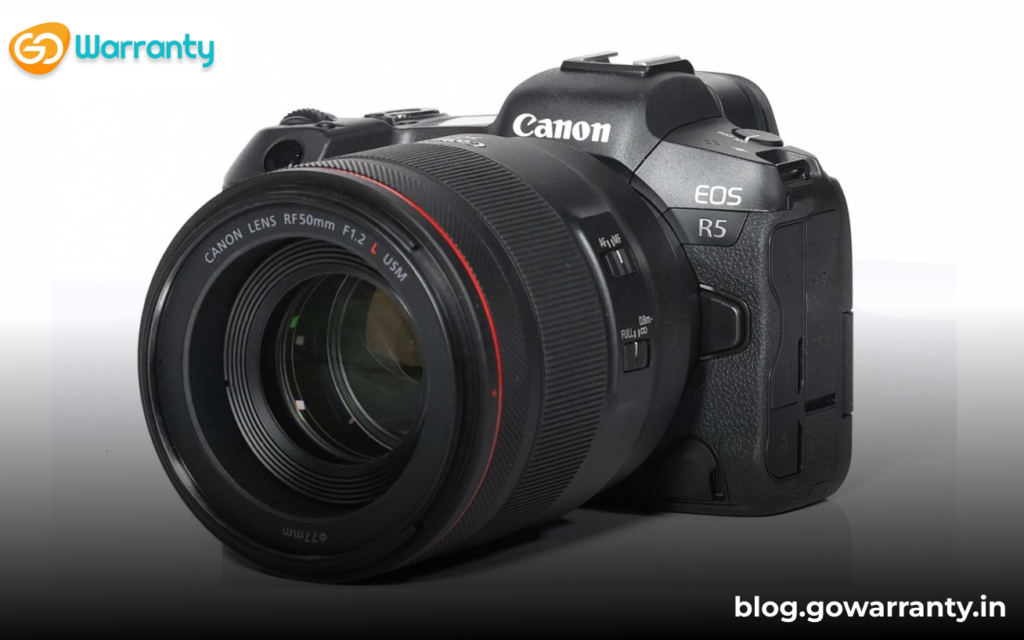After months of anticipation and masterful teases by the – there’s no other word for it exceptionally astute manufacturer, the Canon EOS R5 is finally here. No camera in recent memory has gotten or, dare we say, deserved this much attention. The Canon EOS R5 is a powerhouse performer in every way; its 8K video outperforms many of the best cinema cameras, its shooting speed rivals the best sports cameras, and its 45MP sensor outperforms all but a few of the best mirrorless cameras, and its 8-stop in-body image stabilisation is the new IBIS champion.
The Canon EOS R5 is simply Canon’s best stills camera to date. It combines the form of the EOS R, the function of the EOS 5D, and the professional-grade autofocus of the EOS-1D X. If you’re a stills or hybrid shooter who alternates between photography and videography.

Key Features
Due to the Canon EOS R5’s lofty specifications, nearly every feature is a key feature. Obviously, the remarkable video capability is the main draw here. The R5 can record full-width (uncropped) raw 8K video using the entire readout of the 35mm sensor at up to 29.97fps in 4:2:2 12-bit Canon Log or HDR PQ (both H.265) both in UHD and DCI.
Its 4K capture is just as ferocious, recording at up to 119.88fps (in the same 4:2:2 Canon Log as well as HDR PQ, in UHD or DCI) and external HDMI at up to 59.94fps. However, the R5 is much more than a video powerhouse. Because the 8K DCI video has a resolution of 8,192 x 4,320, the camera has a Frame Grab function that allows you to capture high-resolution 35.4MP stills (as JPEGs) from your footage – 5.1MP more than the Canon EOS R.
Much of the technology in the EOS R5 comes from Canon’s flagship 1D X camera. The AI-powered Deep Learning AF() system has been implanted, allowing the new camera to perform eerie eye, face, and head tracking. However, the R5 has a feature that even the Mark III lacks: Animal AF, which can track the eyes, faces, and bodies of dogs, cats, and birds – including birds in flight.
The R5 also comes with a new 2,130mAh battery, the LP-E6NH, which has 14% more capacity than the LP-E6N it replaces – and it’s backwards-compatible with almost any camera that accepts the LP-E6 family of batteries, so that you can use it with your other cameras as well.
Build and Handling
The EOS R5 feels like a slightly beefier EOS R in the hand. It’s almost imperceptibly thicker (literally just 3.6mm thicker), but it’s significantly heavier, weighing about 70g more. However, the weight is evenly distributed, and the body feels very well balanced – indeed, the extra mass makes it feel like a better match for some of the notoriously larger RF lenses.
From the front, the R5 looks a lot like the EOS R, with the same top OLED screen as well as mode button within the rear control dial. The rear is where the differences begin to show, and the first thing you’ll notice is that the beloved M-Fn touch bar has been replaced by a familiar joystick, with the AF-ON button resuming its more traditional position. The individual D-pad buttons seen on the EOS R as well as Canon EOS RP() have also been replaced by a control wheel, making the R5 feel much more like using a Canon EOS 5D Mark IV fitting, given that this is a 5-series camera intended to sit alongside its DSLR counterpart.
Video Performance
Okay, let’s get right to the point: shooting anything above standard 4K 30p video will cause the Canon EOS R5 to overheat internally, necessitating recording limits to prevent overheating. Shooting 4K 30p causes no overheating, so you can shoot as much video as you want (all recordings are subject to the usual 30-minute limit per single file, although you can record as many 30-minute files as you like). However, the more demanding your video settings, the more limitations you will face.
So shooting 4K 60p will end up causing the camera to overheat in about 35 minutes, while also shooting 8K 30p will cause the camera to overheat in about 20 minutes – after which you must allow the camera to cool down prior to actually recording again (a breakdown can be found here.
This is definitely an issue if you regularly shoot video above 4K 30p. While it is unusual for any production to shoot single 20-minute takes, the overheating issue is cumulative, so if you shoot a series of shorter videos or a lot of stills, the camera innards will already begin to heat up, making it difficult to gauge how much time you can actually record for.
Verdict
The Canon EOS R5 is a product that is both Jekyll and Hyde. It is without a doubt the best camera for photography. Though the A7R IV has more megapixels, and while the 5D Mark IV has better ISO and dynamic range, the R5’s gestalt properties – resolution, frame rates, IBIS, autofocus – make it the undisputed king of all-around, high resolution, high-speed photography.
The importance of autofocus cannot be overstated. If you photograph people or animals, you will automatically benefit from the R5’s advantages. We’d go so far as to say that it’s not only the best camera for wildlife photography, but that any serious wildlife photographer should seriously consider getting one.
The image stabilisation in the EOS R5 is the best we’ve seen on any full-frame system, only surpassed by Olympus and Panasonic Micro Four Thirds cameras (which feature superior IBIS because their sensors are so much smaller). It makes a huge difference when shooting in low light, with long shutter speeds, on long lenses, or without a gimbal.

